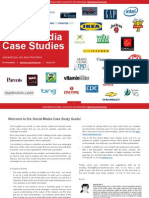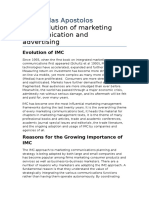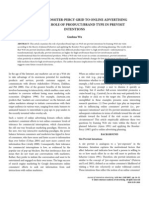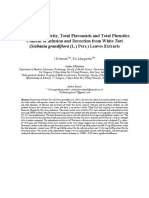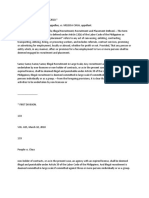The Influence of Users Generated Content On Attitude Towards Brand and Purchase Intentions - Case of Bahrain
The Influence of Users Generated Content On Attitude Towards Brand and Purchase Intentions - Case of Bahrain
Copyright:
Available Formats
The Influence of Users Generated Content On Attitude Towards Brand and Purchase Intentions - Case of Bahrain
The Influence of Users Generated Content On Attitude Towards Brand and Purchase Intentions - Case of Bahrain
Original Title
Copyright
Available Formats
Share this document
Did you find this document useful?
Is this content inappropriate?
Copyright:
Available Formats
The Influence of Users Generated Content On Attitude Towards Brand and Purchase Intentions - Case of Bahrain
The Influence of Users Generated Content On Attitude Towards Brand and Purchase Intentions - Case of Bahrain
Copyright:
Available Formats
International Journal of Business Marketing and Management (IJBMM)
Volume 1 Issue 5 December 2016, P.P.09-20
ISSN : 2456-4559
www.ijbmm.com
The Influence of Users Generated Content on Attitude Towards
Brand And Purchase Intentions – Case of Bahrain
Saleh Shuqair, Philip Cragg, Amir Zaidan, Tijjay Mitchell
Business School, Marketing Major,
Bahrain Polytechnic
ABSTRACT :Purpose: The overarching purpose of this paper is to ascertain whether user generated
content influences consumer purchasing intention, the elements influencing the Electronic Word of Mouth
(eWOM) experience and their perceived attitude towards an associated brand.
Design: A descriptive research design that utilises a quantitative methodology has been favoured. The
research survey was designed to be self-administered and encompasses focused questions that seek to evoke a
set of measurable responses which with analysis can provide clear answers for the research questions through
quantifiable data. A sample size of 170 respondents undertook the research survey.
Findings: Individuals in the Kingdom of Bahrain are significantly influenced by eWOM and they perceive
customers` posts, reviews and shares as more trustworthy than the companies’ posts as they enhance the
attitude towards the brand, increase the customer’s trust and give them a stronger sense of confidence towards
the brand. The highest User Generated Content (UGC) factors impacting customer purchasing intentions and
experience towards a brand were found to be reviews` quality, quantity, source credibility, impact of the
negative reviews and clarity.
The findings indicate that customer attitude towards a brand and purchase intentions are not impacted by “the
reviewer`s geographic location”, “personal knowledge of the reviewer” and “the reviewer`s number of
followers on Social Network Sites” (SNSs).
Originality/value: The research has a Bahrain geographical focus in the absence of prior research and data
in relation to this specific country. This allows for insight to be derived from the research on potential impact of
eWOM on purchasing intentions in the kingdom of Bahrain. The outcome of this may enable further
investigation of impact of eWOM on purchasing intentions. This may also further inform marketing decision
makers in this country.
Keywords: Social Media, User Generated Content (UGC), Electronic Word of Mouth (eWOM), Purchasing
Intentions, Bahrain.
I. Introduction:
Social Media users share stories and experiences on an increasing variety of SNSs about all manner of
products, services and experiences in order to be more engaged with a brand, a product or simply the
opportunity to create personal brand meanings Kirmanico and Dretsch(2014). The impact of UGC in various
forms of videos, images, texts and stories creates “additional value” to the firm Agrawala & Rahman(2015 ) and
this value is typically derived through co-creation. Based on this understanding, companies and corporate alike
are encouraged to adopt new marketing practices aimed at strengthening their marketing proposition and
competitive position, whilst encouraging customers to engage in further co-creation on social media (Founier &
Lee(2009).
Whilst Mir & Rehman (2013) and MacKinnon (2013) have suggested that advertisers should sponsor social
media users to promote their products, this paper takes the view that it is the impact of content being generated
by authentic consumers and Enthusiastic Digital Users (EDU) that is vital, and therefore establishes a greater
degree of trust, mainly due to the review and associated content being considered as transparent and an unbiased
International Journal of Business Marketing and Management (IJBMM) Page 9
The Influence of Users Generated Content on Attitude Towards Brand And Purchase Intentions.....
source of communication. It provides EDUs and customers with an opportunity to engage with brands, in ways
not previously possible prior to the millennium, all of which can have a direct impact on the conversion rate and
purchasing decisions Dennhardt (2012).
UGC, brand communities and customer shares are all considered to be forms of co-creation that can directly or
indirectly influence a customer‟s purchasing intention and create additional value to the firms See-To & Ho
(2014). On this basis, the research study provides insights around the impact of UGC credibility on customer
purchasing intentions and the attitude towards the brand through a quantitative methodology.
According to Manap & Adzharudin (2013) eWOM and UGC are commonly used on an interchangeable basis
as they work exactly like common word–of–mouth.
For the purposes of this research, they shall be considered to have the same generalised meaning and as such
should be considered as interchangeable.
II. Literature review:
eWOM: The term eWOM is an extension of the word of mouth concept that embraces a variety of electronic
communication mediums. Jalilvand et al. (2011) defined it as a “process of consumers sharing information and
opinions about a product or service to others”. The influence of eWOM on the customer`s behavioural intentions
has been examined in several studies including those of, Abalaesei & Sandu (2015) Lin, Wu & Chen (2013),
Khan and Jinnah (2011), and Cheung and Thandi (2010), with the majority of these studies revealing that
eWOM does have a direct impact on the customer‟s purchasing decision. Most of them have discussed the
eWOM from quality, quantity, sender`s expert and source credibility dimensions.
Source credibility: Today, consumers feel that the product recommendations and information, which other
users generate on social media, are more credible than the product advertisements as stated by Mir and Rehman
(2013) . They believed there is no bias in their posts and shares, thus making the message stronger and more
trustworthy. Independently, MacKinnon (2012) and Sharif, Ahmad & Ahmad (2016) draw similar conclusions
on source credibility as being a measurement of the trustworthiness of the UGC source and include aspects such
as, the reviewer‟s expertise and the reputation of the vendor, as an important influencing factor. These authors
further suggest that viewing online reviews or comments helps consumers to be more confident in their purchase
decision making. They also found that “message source credibility” had a significant and positive impact on
consumer purchasing intentions. Another significant factor that influences the purchasing intention is the
website quality, with several studies, including Baia, Lawb (2008) & Sadeh et. al (2011) )and Hasanov & Khalid
(2015), confirming the impact of the website quality on purchasing intentions. Gefen (2000) provides additional
emphasis stating that when customers trust the website they are more likely to trust the customers reviews and
feel that the review is honest and non-biased. Choi and Scott (2013) propose that when eWOM takes place on
social media, once trust and identification allow source credibility to be established, a positive relationship can
be developed based upon the derived social capital. Furthermore, people will assess the social media content in
order to establish trust based upon relevance, helpfulness, accuracy, reliability, or timeliness before sharing the
social media content with friends whom they wish to receive similar benefit.
Quantity of eWOM: For the purpose of the research, quantity of eWOM shall be defined as the number of
online reviews, posts and comments towards the products. Fan et al.(2013) have confirmed that viewing online
comments and the total number of posted comments can increase the customers` confidence and trust towards
the content around a specific product or service. Cheung and Thadani (2012) state that the number of reviews
directly affects the buyers‟ purchase decision, sharing a similar viewpoint. Fan et al. (2013) discuss how the
quantity of eWOM increases the perceived credibility of consumers and suggests that the amount of the reviews
attract customers` attention and lead to establishing customers` trust. Mir and Rehman4 highlighted that the
quantity of posts, views, and reviews has a positive effect on consumers‟ perceived credibility and usefulness of
product content which other users generate on YouTube and they further suggested that more studies need to be
undertaken relating to other SNSs platforms.
Quality of eWOM: Lee (2009) defined the quality of the information as the extent to which users believe that
information is relevant, timely, accurate, and complete. Therefore, we can look to utilise this definition whilst
examining quality of eWOM as it provides some useful components for analysis. Manthiou and Scherir (2010)
highlighted that the “relevance, understandability, sufficiency, objectivity, timeliness, accuracy, persuasiveness,
trustworthiness and expertise of the information” positivity leads to customers` trust and leads to higher degree
of adaption of the information. Yaylc and Bayram (2012) place additional emphasis upon the timeliness of the
review as this can also influence trust and suggest that recent reviews could be more effective on influencing
International Journal of Business Marketing and Management (IJBMM) Page 10
The Influence of Users Generated Content on Attitude Towards Brand And Purchase Intentions.....
purchase decisions. Fan et al. (2013) stated that realistic and persuasive reviews with solid argumentative points
based on factual information about the product can also increase consumer confidence.
User generated contents: According to Moens , Li and Chua (2014) UGC is defined as “any form of content
being generated online by platform users". UGC is rapidly gaining power as a part of purchasing decision
O`Conner (2008). Dennhardt (2014) pointed out that the UGC offers a rich new storytelling opportunity for
marketers to tell their brand story and build a trusted relationship with customers. It was also stated that the
impact of UGC creates new forms of value and competitive advantage Gangi and Wask0 (2009). The impact of
UGC on customers‟ trust was examined in several studies, for instance MacKinnon (2012) revealed that
customers rely heavily on and trust the contents generated by users on the internet. The impact of UGC on
customers is vital as consumers trust content from their peers more than they do any other form of marketing
communication (Dennhardt (2014). According to Cheong and Morrison (2008) there is a lack of research on the
credibility of positive and negative UGC, some of which may have been addressed since their publication.
Social Media Influence & Purchase Intentions: Bughin (2015) provides a significant piece of research
around social media influence upon purchase decisions as it incorporated 20,000 European consumers across 30
product areas and more than 100 brands in 2013 and 2014. The research revealed that there was a greater
influence than previously thought with consumers being directly influenced in two thirds of the product
categories and indirectly in the remaining third. It was also discovered that different product categories
experience different social media influence impact and each specific category has its own group of influencers
with very little overlap. Additionally, first time buyers within these categories were approximately 50% more
likely to be influenced by social media and offline influence was 40% more likely to influence purchase
decisions directly. Analysis of the research also highlighted that a small number of active influencers were
accounting for a large number of recommendations in each category and was particularly noticeable in certain
product areas like shoes and clothing. Utilizing the principles of the long tail model Anderson 30 this also
proposes that there may be potential in reactivating and engaging less active influencers.
The impact of UGC on Brand Attitude: brand attitude has been defined by many researchers as “a lasting
general evaluation of people, objects, advertisements or issues” (Solomon (2009) on the other hand Mitchell and
Olson32 defined brand attitude as a “consumer‟s overall evaluation of a brand”.
According to MacKenzie, S.B. and R.J. Lutz (1989) attitude towards advertising is argued to be positively
related to purchase intention. While Hwang, Yoon, and Park (2011) through investigating into web
advertisements found that response towards advertising is positively related to website attitudes where the latter
would positively influence brand attitude consequently influencing purchase intention positively.
Brand attitude is made up of the overall evaluation of the brand, which encompasses factors such as brand
awareness, brand image, and brand based associations of attributes and benefits Fishbein and Ajzen (
1980)Bruhn et al,(2003). According to Mitchell and Olson (2006) one of the reasons for the long-term interest
into the area of brand attitude can be attributed to the fact that attitudes are relatively stable and enduring and
thus useful predictors of consumer behaviour. Belch and Belch (2003) added that attitudes are also important to
marketers as they provide a summary of a consumers‟ evaluation of the product/service/brand.
Brand attitudes, and equally how they are formed, both impact on the ultimate goal of creating a purchase
intention among consumers (Sicilia, Ruiz and Reynolds (2006), while positive attitudes are created by the firm
generated content or traditional media in the form of advertising, arguably due to the substantial levels of firm
control over this particular type of content generation and circulation Mitchell and Olson (1981) Belch and
Belch (2003); Mangold and Faulds (2009); Bruhn et al. (2012). Mangold and Faulds (2009) on the other hand
state that UGC has considerably changed the strategies and tools used for consumer communication, magnifying
the impact consumer-to-consumer conversations have in the marketplace. The levels of control firms practice
over traditional media are unmatched when it comes to UGC on social media and thus, it can be deducted that
this source of content can be either positive or negative which can mean that UGC can either create a positive or
negative portrayal of a brand impacting the consumers‟ attitude towards it. Bruhn et al (2012). recommended
that UGC in the form of social media must be used in tangent with traditional or firm generated content, as both
exert an important impact on a brand‟s success.
Culture: According to Triandis (1972) culture is defined as “shared perceptions of the social environment” and
as per Tylor (1958) it incorporates language, art, customs, habits, knowledge, morals, and beliefs acquired by a
person in the process of socialization. Markus & Kitayama (1991) state that it affects information processing and
International Journal of Business Marketing and Management (IJBMM) Page 11
The Influence of Users Generated Content on Attitude Towards Brand And Purchase Intentions.....
evaluation, whilst also, having an influence on each individual‟s self-construal and group identification. In
addition, it also has an impact on the mechanism of cognitive stereotyping which leads to classification and
evaluation of self and others in terms of personality traits and similarity, shaping trust, credibility, attitudes, and
behaviours of individuals. According to Kale 43people from different cultures choose different messages and
channels to communicate. Additionally several prior studies identified differences in social relationships and
trust antecedents among cultures (Kim el al.(2011) ; Pavlou & Chai,(2002); Smith et al.(2007). The general
cultural settings of countries and even regions, such as low-context and high-context cultures, impacts the
individual actions, decisions and interaction within society and consequently online. Kim et al.(2011) found
that in a comparative study of motives to join the online social network Facebook, the Korean students were
“seeking social support” and “seeking information” while students in the US joined Facebook for
“entertainment” and “convenience”. The authors suggested that in low-context cultures (like the US),
users join social networks for superficial impression management and casual relationships, while in high-
context cultures (like Korea), the motives are based on the needs to form long-term relationships and define
one‟s group identity. In a different comparative American-Korean study, Lewis & George (2008) identified that
in SNSs there was a positive effect of cultural trait of masculinity on deceptive behaviour.
Money et al.(1998) stated that there haven‟t been studies to date comparing eWOM motivations and usage
patterns in various cultures but existing findings confirm an important role of culture in the frequency and
intensity of traditional WOM. In particular, individualism is likely to facilitate the spread of positive WOM
to out-groups (weak ties), masculinity intensifies WOM sharing with in-groups and uncertainty avoidance is
negatively associated with in- group (strong-tie) WOM. According to Liu et al.(2001) customers in “high
uncertainty-avoidance” cultures proved to be less likely to engage in negative WOM or complain. This paper
will examine the impact of the cultural context within the kingdom of Bahrain.
III. Research Questions:
This study attempts to answer the following questions:
1- Are customers Posts more credible than companies sponsored posts
2-Does using UGC increase purchasing intention
3-Does using UGC enhance the attitudes towards the brand
Methodology: A quantitative research method was carried out to identify the impact of eWOM and UGC
on the purchasing intentions, The first phase of this paper was a literature review that discussed the concepts of
eWOM and UGC from three dimensions, 1) quality of customers` posts , 2) quantity eWOM /customers` posts
and 3) message credibility on the SNSs. The questionnaire consisted of 33 survey items around the influence
of eWOM on the purchasing intention and the second part covered the demographics information of the
respondents. Most variables utilize a four-point Likert scale ranged from Strongly-Agree “4” to Strongly-
Disagree “1” and the rest multiple choice questions. The survey was pre-tested with 17 respondents from
Bahrain Polytechnic in order to check the clarity of the research instrument. It was reproduced based on the test
outcome where some items were removed, added and modified in the questionnaire. The data collection process
was facilitated by Silah Gulf Bahrain Group at which a total of 500 respondents were contacted via an online
questionnaire where a total of 170 responses were received.
IV. Results/Findings:
The demographics of the respondents:
Table 1 reports the demographic of the respondents who participated in this study.
Results:
Table 1 - Reports the Demographics of the Respondents:
Results:
Table 1 - Reports the Demographics of the Respondents:
Demographics Frequency N Percent %
Gender
Male 86 50.6
International Journal of Business Marketing and Management (IJBMM) Page 12
The Influence of Users Generated Content on Attitude Towards Brand And Purchase Intentions.....
Female 84 49.4
Total 170 100
Age Category
Below than 18 years 5 2.9
18 to 25 years 45 26
26 to 34 years 84 49.4
35 to 44 years 27 15.9
45 and above 9 5.1
Total 170 100
Nationality
Bahraini 88 51.7
Non-Bahraini 82 49.3
Education
Less than high school 4 2.4
Completed high school 17 10
Bachelor degree 90 52.9
Advanced degree 29 17.1
Associate degree 30 17.6
Total 170 100
The table above reports the demographic frequencies of the respondents respectively , 50.3% were males and
47.7% females, nearly 50% of the respondents aged between 25-34 , 27% aged between 20-24 and less than
20% aged from 35-44. Half of the respondents 51% hold a Bachelor degree and above 17% hold an advanced
degree. Around 50% of the respondents are Bahraini nationals and the rest are resident expats in Bahrain.
Table 2 – Pre-Purchasing behaviour - Information search Frequency Percentage
Never 29 16.4%
Rarely 37 21.0%
Sometimes 70 39.7%
Often 20 11.9%
Always 20 11.9%
Total 176 100 %
I tend to search online for product reviews before i buy Frequency Percentage
any product
Never 6 3.41%
Rarely 9 5.11%
Sometimes 56 31.82%
International Journal of Business Marketing and Management (IJBMM) Page 13
The Influence of Users Generated Content on Attitude Towards Brand And Purchase Intentions.....
Often 50 28.41%
Always 55 31.25%
Total 176 100%
I have used reviews from a website to inform previous Frequency Percentage
purchasing decisions
Always 39 22.16%
Sometimes 97 55.11%
Rarely 33 18.75%
Never 7 3.98%
Total 176 100%
Table 2 reports the information search behaviour; as stated above the majority of the respondents occasionally
search for online reviews about products and services on SNSs. Only less than 10% of the participants stated
that they never search for online reviews on social media before purchasing new products.
According to the table above, respondents clearly rely on reviews that subsequently inform their purchasing
decisions where 55.1% sometimes rely on reviews and 22.73% feebly rely on reviews from SNSs.
Table 3 – The impact of UGC on Purchasing Intentions:
Survey Item Mean STDV
SNSs Reliability 3.16 0.66
SNSs Rated reviews usefulness 3.14 0.76
Reviews quantity importance 3.10 0.74
SNSs positive reviews influence on purchasing 3.07 0.69
intention
SNSs popularity 3.04 0.73
Customers posts trustworthiness 3.02 0.61
Similarity between SNS review and opinions affect 3.01 0.65
my purchase decision
Review clarity affects my purchase decision. 2.94 0.67
(mistakes, level of detail, etc.
When I buy a product the impact of negative reviews 2.93 0.73
on SNSs effects my purchasing decision
International Journal of Business Marketing and Management (IJBMM) Page 14
The Influence of Users Generated Content on Attitude Towards Brand And Purchase Intentions.....
Customer reviews quantity affects my purchasing 2.87 0.62
decision
SNSs product review recency influence on my 2.81 0.70
purchase decision
Usefulness of the review rating affects my purchase 2.81 0.64
decision
Importance of reviewers authentic name 2.78 0.81
Impact of reviewers frequency of posting on trust 2.67 0.69
Website internationality 2.61 0.72
Trust of undefined source of review 2.43 0.69
Reviewer geographic location influences feelings 2.42 0.75
towards posts
The table above ranks the mean values of the questionnaire items on the impact of eWOM and UGC on the
purchasing intention from the highest to the lowest. Seven survey items were reported above 3.0 on a 4 category
Likert Scale “1” Strongly Disagree and “4” Strongly Agree. The highest mean score was “SNSs Reliability”
(Mean 3.16) followed by “SNSs Rated reviews usefulness” (Mean 3.14), “Reviews quantity importance”(Mean
3.10) and “SNSs positive reviews influence on purchasing intention” (Mean 3.07). Items that addressed the
quality of eWOM, quantity eWOM and source credibility in regards to “the purchasing intentions” were
perceived high; so did the clarity of the reviews, the impact of the negative reviews and the large quantity of the
reviews which also scored high. The lowest reported mean scores were “reviewer geographic location influences
feelings towards posts” ( Mean 2.42), “Trust of undefined source of review” (Mean 2.43) and “website
internationality” ( Mean 2.61).
Table 4 – The Impact of UGC on the attitude towards a brand:
Survey Item Mean STDV
Users` posts increase awareness about the brand 3.14 0.72
Users` posts give impression that the brand has a good 3.04 0.72
quality
Users` posts make the brand more valuable 3.02 0.77
I feel the customers posts are trustworthy 3.01 0.57
Users` posts suggest that the brand is interesting 2.96 0.71
Users` shares increase my brand knowledge 2.96 0.58
SNS positive reviews influence brand feelings 2.90 0.68
International Journal of Business Marketing and Management (IJBMM) Page 15
The Influence of Users Generated Content on Attitude Towards Brand And Purchase Intentions.....
Users` posts impact feelings towards product purchase 2.89 0.72
Users` posts suggest that the brand is safe 2.86 0.73
Reviewer's expertise with a brand influences my feelings 2.84 0.60
towards the brand.
Users` post motivates me to visit pages/links 2.69 0.68
I encourage friends and relatives to buy 2.63 0.69
SNS reviewer's number of followers influences my 2.60 0.68
sentiment towards their posts.
I tend to share customers posts about products 2.54 0.75
The second part of the questionnaire assessed the impact of eWOM and UGC on the attitude towards the brand
using the same measurement technique of a 4 point Likert scale. The most highly rated elements were “Users`
posts increase awareness about the brand” (Mean 3.14) “Users` posts give impression that the brand has a good
quality” (Mean 3.04) The positive reviews on SNSs influence my feelings towards the brand followed by “I feel
the customers posts are trustworthy” (Mean 3.01) “Users` posts make the brand more valuable”(Mean 3.02)
and Users` posts impact feelings towards product purchase (Mean 2.89). Some other items such as the UGC
increase the knowledge about the brand, make it interesting and appear safe were also perceived high.
The last part of the questionnaire aimed to assess the future behavioural intentions of users on social media and
to see if social media posts encourages further posting , as reported above, “I tend to share customers posts
about products” (Mean 2.54) “I encourage friends and relatives to buy” (Mean 2.63).
V. Discussion:
The major objectives of this study were to find the impact of eWOM on purchasing intentions, to investigate the
influence of UGC on the attitude of the consumer towards the brand sentiment and to examine if customers`
posts more credible than companies sponsored posts. The findings illustrate that SNSs users tend to search for
online reviews on social media before purchasing products. The online reviews and comments, coming from
credible sources that are clear and consistent with other reviews, influence their trust and confidence about the
products and leads to purchasing the product. The essence of the research findings apparently suggests that
online reviews are perceived as a credible source of pre-purchase information. At the pre-purchase stage the
findings imply that online reviews were more widely adopted as confirmed in earlier work by Barnes50 where
the author states that eWOM plays an important role in the pre-purchasing stage on SNSs where customers go to
search online for reviews.
This study demonstrates eWOM has a strong impact on individuals in Bahrain; as they “readily” trust online
reviews, customer‟s shares and perceive this information as far more trustworthy than posts by the product
owner, advertisers or corporate. The premise of this being the high context culture of Bahrain facilitates a wider
acceptance and implicit trust by individuals, which is further projected into the social media domain.
Irrespective of the nationalities of respondents, approximately 85% indicated that customer posts were felt to be
more trustworthy than corporate or brand owner reviews. Therefore this indicates that the message source and
its perceived credibility can leverage a greater degree of influence in the decision making process towards
purchasing, an observation also noted in the work of Dennhardt(2014).
The focus and activity of the aggregated online source proved to be of significant relevance in determining the
currency and credibility of the information. The first initial information search online for products and services
that the consumer has little or no knowledge appears to be key in determining future information source
preferences, which one could assume to be an experience-developed preference. Additionally, the reviews also
seem to provide reassurance regarding the pre purchase decision and assist in alleviating post purchase
International Journal of Business Marketing and Management (IJBMM) Page 16
The Influence of Users Generated Content on Attitude Towards Brand And Purchase Intentions.....
dissonance. Throughout the survey there is strong sentiment towards the quality of the UGC suggesting that
potential consumers place some credence in many of the aspects that determine quality UGC. Organisations
also benefit from the inclusion of such content, according to approximately 78% of the respondents it gave the
impression that the organisation was open and honest, therefore one could presume establishing and enhancing
overall trust, which is a major step in the customer‟s purchasing journey. This fits with prevailing thought
around how the customer journey has changed and developed with greater emphasis being placed upon the
influence of such interactions before any purchasing journey is even conceived or initiated, which is also
suggested by O`Conner (2008). Google(2015) discusses the idea of four types of moments, „I-want-to-know, I-
want-to-go, I-want-to-do and I-want-to-buy moments‟, where decisions and preferences are formulated. AoL
(2015) talks about content moments that create content experiences that again can help to engage consumers
through a variety of social mediums and shape their motivations.
Therefore, we could assume that these highly valued pieces of UGC will be more potent within these
increasingly crucial consumer moments, which appears to be an underlying tone drawn from the research and
this premise is further supported by the research carried out by Bughin (2015). This could have significant
implications for marketers as it shifts the focus in the buying process and suggests changes in consumer
behaviour. A greater emphasis upon facilitating and nurturing UGC may be required by marketers in order to
ensure awareness during these customer moments and experiences. Marketers can leverage UGC in order to
enhance engagement, through real customer stories and gain additional associated trust via the UGC. Marketers
may also look to explore a variation of Anderson‟s 30 long tail strategy in order to realise the potential in
developing strategies around fostering wider UGC across a variety of platforms. The significance of this being
highlighted in research from Yahoo et al. (2016) stating, one in three 16-34 year olds in the United States are
social creators, which equates to approximately 25.5 million people in the US alone. However, the key will be
to try and develop a reciprocal and symbiotic relationship where UGC provides insight beyond the traditional
marketing boundaries.
This study indicates that the customers have a stronger power in communication as the majority of the
respondents believe that the posts, shares and contents being generated by social media users provide additional
value to the companies in regards to the brand awareness, knowledge and the positive feelings towards the
brands. The findings also highlight that the generated content by the customers help firms by creating
impressions that the brand is safe, interesting and of good quality. Thus EDU posts appear to be more
trustworthy and credible and consumers heavily rely on them, the findings are consistent with similar studies
such as MacKinnon (2012).
Marketing Implications: This study contributes to the existing literature and provides a number of
pertinent marketing implications in regards to the companies‟ practices:
Adopt and deploy employee UGC posting in-order to increase social network reach that engages across multiple
platforms
Initiate pro-active social monitoring programs that build profiles of the insights into the UGC discussions and
forums for the purpose of maintaining positive content on SNSs postings.
Develop user guidelines and templates to encourage users to adopt, in order to enhance and maintain the quality
of the UGC
Engage in two way UGC conversations to encourage further postings and broaden the appeal of the brand
Nurture and create relationships such as UGC incentive program that drive engagement with the addressable
audience universe
Adopt Long-Tail strategy Anderson (2004) to encourage smaller niche batches of UGC that can potentially
obtain better or similar results to those of professional bloggers
Encourage searchable UGC and SEO using hash tags in order to improve the reviews‟ ranking on search results
Limitation and future research: The study was conducted in Bahrain and the majority of the survey
respondents belong to generation Y; hence generalizing the findings has to happen with caution due to
International Journal of Business Marketing and Management (IJBMM) Page 17
The Influence of Users Generated Content on Attitude Towards Brand And Purchase Intentions.....
geographical and demographic context. Our study raised some questions to be examined in the future such as
does eWOM drive business growth? What are the implications of eWOM on marketing management? what is
driving the ongoing strength , within internet of things, social media platforms and authenticating customers.
Can the impact of eWOM be measured and distinguished from other MarCom. Can eWOM be demystified?
VI. Acknowledgment:
We would like to acknowledge Silah Gulf Bahrain company for facilitating the data collection process.
Reference List:
[1.] Abalaesi, M. and Sandu, R. (2015) „Factors Influencing the Adoption of Electronic word of
mouth‟,SEA - Practical Application of Science, 111(3), pp. 117–123.
[2.] Agrawal, A.K. , Kaushik, A.K. and Rahman, Z. (2015), “Co-creation of social value through
integration of stakeholders”, Procedia – Social and Behavioral Sciences , Vol. 189 No. 1, pp. 442-448.
[3.] Ajzen, I. and Fishbien, M. (1980). „Understanding Attitudes and Predicting Social Behaviour‟. New
Jersey; Prentice Hall.
[4.] Anderson, Chris. ( 2004). „The Long Tail‟. Wired. [Online] Available at:
<http://www.wired.com/2004/10/tail/> [Accessed: 20/06/2016]
[5.] AoL. (2015). Content Marketing, White Paper. [Online] Available at:
<http://advertising.aol.com/content-marketing-eight-moments> [Accessed: 19/06/2016]
[6.] Bai, B., Law, R. and Wen, I. (2008) „The impact of website quality on customer satisfaction and
purchase intentions: Evidence from Chinese online visitors‟, International Journal of Hospitality
Management, 27(3), pp. 391–402. doi: 10.1016/j.ijhm.2007.10.008.
[7.] Barnes, N. (2015) „EWOM Drives Social Commerce: A Survey of Millennials in US and
Abroad‟,Journal of Marketing Development and Competitiveness, 9(2), pp. 36–46.
[8.] Belch, G. and Belch, A. (2003) „Advertising and Promotion: An Integrated Marketing Communications
Perspective‟, New York. McGraw-Hill. 6th edn.
[9.] Bruhn, M., Schoenmueller, V., and Scafer, D. (2012), „Are social media replacing traditional media in
terms of brand equity creation?‟, Department of Marketing and Management, University of Basel,
Management Research Review, Vol. 35 No. 9, 2012 pp. 770-790.
[10.] Bughin, Jacques. (2015). „Getting a sharper picture of social media‟s influence‟. McKinsey Quarterly.
Issue, July 2015.
[11.] Cheong, H., & Morrison, M. (2008). Consumers‟ reliance on product information and
recommendations found in ugc. Journal of Interactive Advertising, 8(2),
[12.] Cheung, C. M. K., & Thadani, D. R. (2012). The impact of electronic word-of-mouth communication:
A literatureanalysis and integrative model. Decision Support Systems, 54 (1), 461-470.
[13.] Cheung, M. K., & Thadani, R. (2010).The effectiveness of electronic Word-of-Mouth communication: a
literature analysis. Paper presented at the 23rd Beld eConference - eTrust: Implications for the
individual, Enterprises and Society, Bled, Slovenia.
[14.] Choi, J. and Scott, J. (2013) „Electronic word of mouth and knowledge sharing on social network sites:
A social capital perspective‟, Journal of theoretical and applied electronic commerce research, 8(1),
pp. 11–12. doi: 10.4067/s0718-18762013000100006.
[15.] Chua, Tat-Seng; Juanzi, Li; Moens, Marie-Francine (2014). Mining user generated content. Chapman
and Hall/CRC. p. 7.
[16.] Dennhardt, S. (2014) User-generated content and its impact on Branding: How users and communities
create and manage brands in social media. Wiesbaden: Springer Fachmedien Wiesbaden.
[17.] Di Gangi, P. M. & Wasko, M. (2009a). Steal my idea! User innovation community influence on
organizational adoption of user innovations: A case study of Dell IdeaStorm. Decision Support
Systems, doi: 10.1016/j.dss.2009.04.004.
[18.] Dretsch, J., Heather and Kirmani, A. (2014) Why are some brand Co-Creation activities more effective
than others? The effects of brand knowledge potential and self-brand connection on brand engagement
intentions by Heather Johnson Dretsch and Amna Kirmani.
[19.] Fan, Y.-W., Miao, Y.-F., Fang, Y.-H. and Lin, R.-Y. (2013) „Establishing the adoption of electronic
word-of-mouth through consumers‟ perceived credibility‟, International Business Research, 6(3). doi:
10.5539/ibr.v6n3p58
[20.] Fournier, S. Lee, L. (2009) Getting brand communities right. [Online] Available at:
<https://hbr.org/2009/04/getting-brand-communities-right> [Accessed: 21 April 2016]
[21.] Gefen, D. (2000). E-Commerce: The role of familiarity and trust, The International Journal of
Management Science 28 (6): 725-737.
International Journal of Business Marketing and Management (IJBMM) Page 18
The Influence of Users Generated Content on Attitude Towards Brand And Purchase Intentions.....
[22.] Google (2015). 4 New Moments Every Marketer Should Know. [Online] Available at:
<https://www.thinkwithgoogle.com/infographics/4-new-moments-every-marketer-should-know.html>
[Accessed: 20/06/2016]
[23.] Hasanov, J. and Khalid, H. (2015) „The impact of Website quality on online purchase intention of
organic food in Malaysia: A WebQual model approach‟, Procedia Computer Science, 72, pp. 382–389.
doi: 10.1016/j.procs.2015.12.153.
[24.] Hwang, J., Y.-S. Yoon, and N.-H. Park, (2011). Structural effects of cognitive and affective reponses to
web advertisements, website and brand attitudes, and purchase intentions: The case of casual-dining
restaurants. International Journal of Hospitality Management, 2011. 30(4): p. 897-907.
[25.] Jalilvand MR, Esfahani SS, Samiei N. (2011). Electronic word-of-mouth: challenges and
opportunities, Proc. Comput. Sci., 3, 42–46.
[26.] Kale, S. H. (1991),” Culture-specific marketing communications: An analytical approach” International
Marketing Review, Vol. 8, No. 2.
[27.] Khan, M. and Jinnah, M. (2011) „The Impact of E-Media on Customer Purchase
Intention‟,International Journal of Advanced Computer Science and Applications, 3(2), pp. 100–103.
[28.] Kim, Y., Sohn, D. and Choi, S.M. (2011), „Cultural difference in motivations for using social network
sites: a comparative study of American and Korean college students‟, Computers in Human Behavior,
Vol. 27, No. 1, pp. 365-372.
[29.] Lee, S.F. (2009) Getting brand communities right. [Online] Available at:
<https://hbr.org/2009/04/getting-brand-communities-right> [Accessed: 21 April 2016].
[30.] Lewis, C. C. and George, J. F. (2008), „Cross-cultural deception in social networking sites and face to-
face communication‟, Computers in Human Behavior, Vol. 24, No. 6, pp. 2945-2964.
[31.] Lin, C., Wu, Y., & Chen, J. (2013). Electronic Word-Of-Mouth: The Moderating Roles Of Product
Involvement And Brand Image. Proceedings of 2013 international conference on technology
innovation and industrial management, Phuket, Thailand.
[32.] Liu, B.S.C., Furrer, O. and Sudharshan, D. (2001), „The relationships between culture and behavioural
intentions toward services‟, Journal of Service Research, Vol. 4, No. 2, pp. 118-129.
[33.] MacKenzie, S.B. and R.J. Lutz, (1989). An empirical examination of the structural antecedents of
attitude toward the Ad in an advertising pretesting context. The Journal of Marketing, 1989. 53(2): p.
48-65
[34.] MacKinnon, K. (2012) „User Generated Content vs. Advertising: Do Consumers Trust the Word of
Others Over Advertisers?‟, The Elon Journal of Undergraduate Research in Communications, 3(1), pp.
14–22.
[35.] Manap, K. H. A., & Adzharudin, N. A. (2013). The Role of User Generated Content (UGC) in Social
Media for Tourism Sector. In West East Institute International Academic Conference Proceedings (pp.
52–58). Istanbul, Turkey.
[36.] Mangold, W., G. and Faulds, D., J. (2009) „Social Media: The New Hybrid Element of the Promotion
Mix‟, Business Horizons 52, no. 4 (July): 357–365.
[37.] Manthiou, A. and Schrier, T. (2010) „a comparison of traditional vs electronic word of mouth in the
Greek hotel market: an exploratory STUDY‟, Journal of Tourism Research, 10(1)
[38.] Markus, Hazel R. and Shinobu Kitayama (1991), “Culture and the Self: Implications for Cognition,
Emotion, and Motivation,” Psychological Review, 98 (2), 224–53.
[39.] Mir, I. and Rehman, K. (2013) „FACTORS AFFECTING CONSUMER ATTITUDES AND
INTENTIONS TOWARD USER-GENERATED PRODUCT CONTENT ON
YOUTUBE‟, Management & Marketing Challenges for the Knowledge Society, 8(4), pp. 637–654.
[40.] Mitchell, Andrew A., and Jerry C. Olson, (1981). "Are Product a Beliefs the Only Mediator of
Advertising Effects on Brand Attitude." Journal of Marketing Research, 18 (August), 318-332.
[41.] Money, R.B., Gilly, M.C. and Graham, J.L. (1998), „Explorations of national culture and word of
mouth referral behavior in the purchase of industrial services in the United States and Japan‟, The
Journal of Marketing, pp. 76-87
[42.] O'Connor, Peter. (2008). "User-Generated Content and Travel: A Case Study on TripAdvisor.com". In
: Proceedings of the 15th International Conference on Information and Communications Technology i
Tourism, ENTER 2008. New York (USA) : Springer Computer Science, 2008, p. 61-72.
[43.] Pavlou, P.A. and Chai, L. (2002), „What drives electronic commerce across cultures? Across-cultural
empirical investigation of the theory of planned behavior‟, Journal of Electronic Commerce Research,
Vol. 3, No. 4, pp. 240-253.
[44.] Sadeh, S., Sadeh, E., Mousavi, L. and Asgari, 3f. (2011) „The Effects of Website Quality Dimensions
on Customer Satisfaction in E-Retailing System‟, Middle-East Journal of Scientific Research, 10(3),
pp. 366–369.
International Journal of Business Marketing and Management (IJBMM) Page 19
The Influence of Users Generated Content on Attitude Towards Brand And Purchase Intentions.....
[45.] See-To, E.W.K. and Ho, K.K.W. (2014), “Value co-creation and purchase intention in social network
sites: the role of electronic word-of-mouth and trust – a theoretical analysis”, Computers in Human
Behavior, Vol. 31, pp. 182-189.
[46.] Sharif, M.A., Ahmad, W and Ahmad, A. (2016) „Electronic word of mouth: investigating the influence
of electronic message source credibility, message appeal and brand equity on consumer purchase
intention‟, City University Research Journal, 06 (01) pp 151-165.
[47.] Sicilia, M., Ruiz, S., and Reynolds, N. (2006) 'Attitude formation online: How the consumer's need for
cognition affects the relationship between attitude towards the website and attitude towards the brand',
International Journal of Market Research, 48, 2, pp. 139-154.
[48.] Smith, T., Coyle, J.R., Lightfoot, E. and Scott, A. (2007), „Reconsidering models of influence:the
relationship between consumer social networks and word-of-mouth effectiveness‟, Journal of
Advertising Research, Vol. 47, No. 4, pp. 387-397.
[49.] Solomon, M.R., (2009). Consumer Behavior Buying, Having and Being. 8th ed. 2009, New Jersey:
Pearson education
[50.] Triandis, Harry C. (1972), The Analysis of Subjective Culture.Oxford: Wiley-Interscience.
[51.] Tylor, Sir Edward Burnett (1871 [1958]), The Origins of Culture,Part 1 of Primitive Culture. New
York: Harper.
[52.] Yahoo, Deep Focus, Shareablee and Ipsos. (2016). Unlocking Influencer Marketing. [Online]
Available at: <https://advertising.yahoo.com/Insights/UNLOCK-INFLUENCER-MARKETING.html>
[Accessed: 22/06/2016].
[53.] Yaylc, A. and Bayram, M. (2012) „E-wOM: The effects of online consumer reviews on purchasing
decisions‟, International Journal of Internet Marketing and Advertising, 7(1), p. 51. doi:
10.1504/ijima.2012.044958
International Journal of Business Marketing and Management (IJBMM) Page 20
You might also like
- Impact of Influencer Marketing To Consumer BehaviorDocument83 pagesImpact of Influencer Marketing To Consumer BehaviorAndrėja Ju'100% (5)
- Kotler Roberto Lee Social MKT ContentsDocument7 pagesKotler Roberto Lee Social MKT ContentsAlbi Panatagama0% (1)
- 5.place Value Routine 5th Grade Lesson PlanDocument3 pages5.place Value Routine 5th Grade Lesson PlanSeema GulNo ratings yet
- Lionbridge JobDocument8 pagesLionbridge JobNew Top Music VideosNo ratings yet
- Impact of Social Media Marketing On Consumer Buying Behavior: A Study Based On Clothing Brands in Sri LankaDocument12 pagesImpact of Social Media Marketing On Consumer Buying Behavior: A Study Based On Clothing Brands in Sri LankaInternational Journal of Business Marketing and ManagementNo ratings yet
- Measure of Impact of Social Media Marketing On MillennialsDocument14 pagesMeasure of Impact of Social Media Marketing On MillennialsTeetas SahaNo ratings yet
- The Impact of Electronic Word-Of-Mouth Communication: A Literature Analysis and Integrative ModelDocument10 pagesThe Impact of Electronic Word-Of-Mouth Communication: A Literature Analysis and Integrative ModelDaren Kuswadi0% (1)
- 21st Century Secrets to Effective PR: Tips and best practices for gaining media exposureFrom Everand21st Century Secrets to Effective PR: Tips and best practices for gaining media exposureNo ratings yet
- Social Media Marketing: A Comprehensive Guide to Growing Your Brand on Social MediaFrom EverandSocial Media Marketing: A Comprehensive Guide to Growing Your Brand on Social MediaNo ratings yet
- First Interview SummaryDocument2 pagesFirst Interview Summaryapi-537611054No ratings yet
- Social Media Marketing a Strategic Guide: Learn the Best Digital Advertising Approach & Strategies for Boosting Your Agency or Business with the Power of Facebook, Instagram, YouTube, Google SEO & MoreFrom EverandSocial Media Marketing a Strategic Guide: Learn the Best Digital Advertising Approach & Strategies for Boosting Your Agency or Business with the Power of Facebook, Instagram, YouTube, Google SEO & MoreRating: 5 out of 5 stars5/5 (28)
- Social Media Marketing: The Ultimate Guide to Learn Step-by-Step the Best Social Media Marketing Strategies to Boost Your BusinessFrom EverandSocial Media Marketing: The Ultimate Guide to Learn Step-by-Step the Best Social Media Marketing Strategies to Boost Your BusinessRating: 4.5 out of 5 stars4.5/5 (2)
- Lessons in Social Media: Social Media Marketing 2023: Lessons in Digital MarketingFrom EverandLessons in Social Media: Social Media Marketing 2023: Lessons in Digital MarketingRating: 5 out of 5 stars5/5 (1)
- User-Generated Content and Travel A Case Study On Trip AdvisorDocument12 pagesUser-Generated Content and Travel A Case Study On Trip AdvisorEsther Charlotte Williams100% (1)
- 2012 - Smith, Fischer, Yongjian - How Does Brand-Related User-Generated Content Differ Across YouTube, Facebook, and Twitter PDFDocument12 pages2012 - Smith, Fischer, Yongjian - How Does Brand-Related User-Generated Content Differ Across YouTube, Facebook, and Twitter PDFgvspavanNo ratings yet
- The Influencer MarketingDocument6 pagesThe Influencer MarketingAmanda MeisandyNo ratings yet
- Sevil Yesiloglu, Joyce Costello (Eds.) - Influencer Marketing. Building Brand Communities and Engagement-Routledge (2021)Document323 pagesSevil Yesiloglu, Joyce Costello (Eds.) - Influencer Marketing. Building Brand Communities and Engagement-Routledge (2021)Alexandra Diana PalNo ratings yet
- Impact of Influencers in Consumer DecisiDocument14 pagesImpact of Influencers in Consumer DecisiKrishna Mohan PoddarNo ratings yet
- Social Media Marketing Adoption StrategiesDocument10 pagesSocial Media Marketing Adoption StrategiesMAGESWARI A/P SUTHAGARAN MoeNo ratings yet
- Effectiveness of Instagram Marketing and Social Media InfluencersDocument22 pagesEffectiveness of Instagram Marketing and Social Media InfluencersAman KureelNo ratings yet
- Impact of Celebrity Advertisement On Customer Brand Perception and Purchase Intention in MalaysiaDocument19 pagesImpact of Celebrity Advertisement On Customer Brand Perception and Purchase Intention in MalaysiaWengSeng WsNo ratings yet
- Role of Social Media in Consumer Buying Behaviour For Cosmetics ProductsDocument10 pagesRole of Social Media in Consumer Buying Behaviour For Cosmetics ProductsHossain ArifNo ratings yet
- Factors Affecting Live SellingDocument27 pagesFactors Affecting Live Selling수지No ratings yet
- Electronic Word of Mouth and Word of MouthDocument48 pagesElectronic Word of Mouth and Word of MouthmanishNo ratings yet
- Why Integration Marketing: Essential of Integrated Marketing CommunicationsFrom EverandWhy Integration Marketing: Essential of Integrated Marketing CommunicationsNo ratings yet
- The Impact of Social Media Marketing TodayDocument14 pagesThe Impact of Social Media Marketing Todayroshit motwani0% (1)
- Communication Theories Models PDFDocument2 pagesCommunication Theories Models PDFAdrianne100% (2)
- No Kidding With FlipkartDocument5 pagesNo Kidding With FlipkartShahnawaz AadilNo ratings yet
- Social Media Case StudiesDocument9 pagesSocial Media Case StudiesEve DmochowskaNo ratings yet
- Social Media MarketingDocument59 pagesSocial Media MarketingTabrej Khan75% (4)
- Influence of Social Media Marketing On Consumer Buying Decision Making ProcessDocument5 pagesInfluence of Social Media Marketing On Consumer Buying Decision Making ProcessAyessa Faye Dayag FernandoNo ratings yet
- The Influence of EWOM in Social Media On Wd4w1dDocument9 pagesThe Influence of EWOM in Social Media On Wd4w1djazzloveyNo ratings yet
- Best Practices In Influencer Marketing: Insights from Digital Marketing ExpertsFrom EverandBest Practices In Influencer Marketing: Insights from Digital Marketing ExpertsRating: 4 out of 5 stars4/5 (8)
- Consumer Engagement in Electronic Word-Of-mouth On Social Networking SitesDocument29 pagesConsumer Engagement in Electronic Word-Of-mouth On Social Networking SitesGianinaNo ratings yet
- Celebrity Endorsement Impact in MalaysiaDocument14 pagesCelebrity Endorsement Impact in MalaysiaWengSeng WsNo ratings yet
- Social Media, MarketingDocument19 pagesSocial Media, MarketingmartynaNo ratings yet
- Social Media CampaignDocument35 pagesSocial Media Campaignapi-211073206No ratings yet
- The Use of Social Media in b2b Marketing and BrandingDocument16 pagesThe Use of Social Media in b2b Marketing and BrandingDiego Hanan HerreraNo ratings yet
- Social Media MarketingDocument7 pagesSocial Media MarketingVinod Kumar NNo ratings yet
- Effectiveness of Social Media MarketingDocument54 pagesEffectiveness of Social Media MarketingAmit AggarwalNo ratings yet
- The Impact of Social Media Marketing On Brand Loyalty - ScienceDirect PDFDocument8 pagesThe Impact of Social Media Marketing On Brand Loyalty - ScienceDirect PDFWasseem AtallaNo ratings yet
- The Evolution of Marketing Communication and AdvertisingDocument2 pagesThe Evolution of Marketing Communication and AdvertisingZerakos100% (1)
- Marketing CommunicationDocument45 pagesMarketing CommunicationSreejesh Jaychandran100% (3)
- The Effect of Brand Credibility On Consumers Brand Purchase Intention in Emerging Economies - The Moderating Role of Brand Awareness and Brand ImageDocument13 pagesThe Effect of Brand Credibility On Consumers Brand Purchase Intention in Emerging Economies - The Moderating Role of Brand Awareness and Brand ImageWaqas Saleem MirNo ratings yet
- Social Media Vs Traditional MarketingDocument13 pagesSocial Media Vs Traditional MarketingBrea GeniceNo ratings yet
- Effectiveness of Social Media Advertising-A Study in Khulna CityDocument49 pagesEffectiveness of Social Media Advertising-A Study in Khulna CitySadman Rahman ShourovNo ratings yet
- Social Media Marketing Power Mindset: Learn The Online Digital Advertising Strategies That Can Help Grow Your Business, Network, And Influencer Brand on Facebook, Instagram, LinkedIn and YouTube.: Social Media Marketing MasterclassFrom EverandSocial Media Marketing Power Mindset: Learn The Online Digital Advertising Strategies That Can Help Grow Your Business, Network, And Influencer Brand on Facebook, Instagram, LinkedIn and YouTube.: Social Media Marketing MasterclassNo ratings yet
- Ethics in AdvertisingDocument26 pagesEthics in AdvertisingJustGKNo ratings yet
- Instagram Marketing PDFDocument72 pagesInstagram Marketing PDFneeloufershaik100% (1)
- Brand Awareness and Brand Loyalty - DLFDocument65 pagesBrand Awareness and Brand Loyalty - DLFRaju Thota0% (1)
- Social Media MarketingDocument38 pagesSocial Media MarketingShashank JoganiNo ratings yet
- Media and CommunityDocument72 pagesMedia and CommunityyfNo ratings yet
- Social Media As A Marketing ToolDocument20 pagesSocial Media As A Marketing ToolRaul ChindrișNo ratings yet
- How To Measure Influencer Marketing RoiDocument14 pagesHow To Measure Influencer Marketing Roihandoko lim100% (1)
- Applying The Rossiter-Percy Grid To Online Advertising Planning - The Role of Product - Brand Type in Previsit IntentionsDocument9 pagesApplying The Rossiter-Percy Grid To Online Advertising Planning - The Role of Product - Brand Type in Previsit Intentionsa861108No ratings yet
- Social Media MarketingDocument55 pagesSocial Media MarketingRohit Bebarta100% (1)
- Twitter Marketing TipsDocument6 pagesTwitter Marketing TipsAleks VNo ratings yet
- Impact of Advertising On Consumer BehaviourDocument73 pagesImpact of Advertising On Consumer BehaviourdanielNo ratings yet
- Social Media Marketing TrendsDocument21 pagesSocial Media Marketing TrendsDigimindz India100% (1)
- A Study ON Impact OF Social Media Marketing and Advertising ON Consumer Buying BehaviourDocument44 pagesA Study ON Impact OF Social Media Marketing and Advertising ON Consumer Buying Behaviourjeel rabadiya100% (6)
- The Impact of Social Media Influencers On Purchase IntentionDocument18 pagesThe Impact of Social Media Influencers On Purchase IntentionBambi MrrNo ratings yet
- GDP Modeling Using Autoregressive Integrated Moving Average (ARIMA) : A Case For Greek GDPDocument10 pagesGDP Modeling Using Autoregressive Integrated Moving Average (ARIMA) : A Case For Greek GDPInternational Journal of Business Marketing and ManagementNo ratings yet
- Exploring The Value of Workplace Training: A Literature Review of Practices, Assessment Models, Challenges, and SolutionsDocument11 pagesExploring The Value of Workplace Training: A Literature Review of Practices, Assessment Models, Challenges, and SolutionsInternational Journal of Business Marketing and ManagementNo ratings yet
- Impact of Corruption On Foreign Direct Investment: An Empirical Analysis For Sri LankaDocument13 pagesImpact of Corruption On Foreign Direct Investment: An Empirical Analysis For Sri LankaInternational Journal of Business Marketing and ManagementNo ratings yet
- Financial Literacy Amongst Small Scale Farmers in ZambiaDocument13 pagesFinancial Literacy Amongst Small Scale Farmers in ZambiaInternational Journal of Business Marketing and Management100% (1)
- Analysis of The Influence of Company Size On The Timeliness of Financial Reporting by Mediating Profitability and Leverage in Companies Listed On The Indonesian Stock ExchangeDocument7 pagesAnalysis of The Influence of Company Size On The Timeliness of Financial Reporting by Mediating Profitability and Leverage in Companies Listed On The Indonesian Stock ExchangeInternational Journal of Business Marketing and ManagementNo ratings yet
- Impediments Encountered by Women Entrepreneurs in India: An OverviewDocument8 pagesImpediments Encountered by Women Entrepreneurs in India: An OverviewInternational Journal of Business Marketing and ManagementNo ratings yet
- The Effect of Return On Assets (ROA) and Earning Per Share (EPS) On Stock Returns With Exchange Rates As Moderating VariablesDocument5 pagesThe Effect of Return On Assets (ROA) and Earning Per Share (EPS) On Stock Returns With Exchange Rates As Moderating VariablesInternational Journal of Business Marketing and ManagementNo ratings yet
- Adoption of Halal Assurance Management Systems in Poultry Farming in Brunei DarussalamDocument10 pagesAdoption of Halal Assurance Management Systems in Poultry Farming in Brunei DarussalamInternational Journal of Business Marketing and ManagementNo ratings yet
- The Chinese Influence in Africa: Neocolonialism or Genuine Cooperation?Document9 pagesThe Chinese Influence in Africa: Neocolonialism or Genuine Cooperation?International Journal of Business Marketing and ManagementNo ratings yet
- Statistical Analysis of Real Estate StocksDocument5 pagesStatistical Analysis of Real Estate StocksInternational Journal of Business Marketing and ManagementNo ratings yet
- Patterns of Expenditure of Older People in Rural IndonesiaDocument5 pagesPatterns of Expenditure of Older People in Rural IndonesiaInternational Journal of Business Marketing and ManagementNo ratings yet
- Effect of Risk, Capital, Good Corporate Governance, Efficiency On Financial Performance at Islamic Banks in IndonesiaDocument8 pagesEffect of Risk, Capital, Good Corporate Governance, Efficiency On Financial Performance at Islamic Banks in IndonesiaInternational Journal of Business Marketing and ManagementNo ratings yet
- Analysis of Conflict and Organizational Environment On Performance and Their Impact On Organizational Competitiveness Case Study: Regional Secretariat East Java Province, IndonesiaDocument14 pagesAnalysis of Conflict and Organizational Environment On Performance and Their Impact On Organizational Competitiveness Case Study: Regional Secretariat East Java Province, IndonesiaInternational Journal of Business Marketing and ManagementNo ratings yet
- Intellectual Capital Effect On Financial Performance and Company Value (Empirical Study On Financial Sector Companies Listed On The Indonesia Stock Exchange in 2020)Document11 pagesIntellectual Capital Effect On Financial Performance and Company Value (Empirical Study On Financial Sector Companies Listed On The Indonesia Stock Exchange in 2020)International Journal of Business Marketing and ManagementNo ratings yet
- Social Media As A Way of Fostering Financial Inclusion To Marginalized Rural CommunitiesDocument9 pagesSocial Media As A Way of Fostering Financial Inclusion To Marginalized Rural CommunitiesInternational Journal of Business Marketing and ManagementNo ratings yet
- The Effect of Consumer Attitude and Physical Environment On Buying Decisions by Brand Equity at Gramedia Book Store Matos MalangDocument7 pagesThe Effect of Consumer Attitude and Physical Environment On Buying Decisions by Brand Equity at Gramedia Book Store Matos MalangInternational Journal of Business Marketing and ManagementNo ratings yet
- Influence of Personal Character On Visitor Satisfaction Through Traffic Engineering in The City of Stone TourDocument4 pagesInfluence of Personal Character On Visitor Satisfaction Through Traffic Engineering in The City of Stone TourInternational Journal of Business Marketing and ManagementNo ratings yet
- Conceptualisation of Student Satisfaction in The Context of UK Higher EducationDocument22 pagesConceptualisation of Student Satisfaction in The Context of UK Higher EducationInternational Journal of Business Marketing and ManagementNo ratings yet
- Personal Prophetic Leadership As A Model of Intrinsic Character EducationDocument14 pagesPersonal Prophetic Leadership As A Model of Intrinsic Character EducationInternational Journal of Business Marketing and ManagementNo ratings yet
- Fifty Years of Bangladesh: Achievement in Population SectorDocument6 pagesFifty Years of Bangladesh: Achievement in Population SectorInternational Journal of Business Marketing and ManagementNo ratings yet
- Islamiat Mcq's For PPSCDocument14 pagesIslamiat Mcq's For PPSCmksaifi736No ratings yet
- JaundiceDocument6 pagesJaundiceKesyaNo ratings yet
- fINAL - 3RD QTR WEEK1 SCIENCEDocument3 pagesfINAL - 3RD QTR WEEK1 SCIENCEJessa T. BerdinNo ratings yet
- CHAPTER 15 ProbabilityDocument17 pagesCHAPTER 15 ProbabilityTeam RtobNo ratings yet
- Memorial Day InfographicDocument2 pagesMemorial Day InfographicLakeCoNewsNo ratings yet
- G1 English Syllabus Sy18 19Document19 pagesG1 English Syllabus Sy18 19Dave Anthony PascualNo ratings yet
- Ausubel's Meaningful Verbal Learning/ Subsumption Theory: Reporters: Ryne Romwel Guzman Oliver DillaDocument17 pagesAusubel's Meaningful Verbal Learning/ Subsumption Theory: Reporters: Ryne Romwel Guzman Oliver DillaWennie Lyn Asprin100% (1)
- Instant ebooks textbook Projective Identification in the Clinical Setting A Kleinian Interpretation 1st Edition Robert Waska download all chaptersDocument71 pagesInstant ebooks textbook Projective Identification in the Clinical Setting A Kleinian Interpretation 1st Edition Robert Waska download all chaptersluomgametsi100% (2)
- AIPCP AbstractDocument1 pageAIPCP AbstractJmltr RhmhNo ratings yet
- BismillahirrahmânirrahîmDocument8 pagesBismillahirrahmânirrahîmyirgalemle ayeNo ratings yet
- Y2007 (Bard - A.J., - Stratmann - M., - Unwin - P.R.) - Encyclopedia PDFDocument642 pagesY2007 (Bard - A.J., - Stratmann - M., - Unwin - P.R.) - Encyclopedia PDFDian NursyamsiahNo ratings yet
- PHD Thesis Daniel MontofreDocument172 pagesPHD Thesis Daniel MontofreBryan GuevaraNo ratings yet
- Genetics IntroDocument30 pagesGenetics IntroVin BaniquedNo ratings yet
- Bloomberg Professional For Bond Pricing & Yield To MaturityDocument5 pagesBloomberg Professional For Bond Pricing & Yield To Maturityjujonet100% (1)
- Shape FuncDocument33 pagesShape FuncSAMNo ratings yet
- The Very Basic English GrammarDocument7 pagesThe Very Basic English GrammarPadhy ParthosarathiNo ratings yet
- Q1 LE Science4 Lesson7 Week-7Document12 pagesQ1 LE Science4 Lesson7 Week-7Carolyn CarolNo ratings yet
- Zeta Macedonia: Vermont, USADocument3 pagesZeta Macedonia: Vermont, USAwaleexasNo ratings yet
- Literature Stage 3 Heaney OralsDocument3 pagesLiterature Stage 3 Heaney Oralsjaz2423No ratings yet
- Impact of Covid 19 On Employee Retention in The Hospitality IndustryDocument11 pagesImpact of Covid 19 On Employee Retention in The Hospitality IndustryGeorgeta CazacNo ratings yet
- Girl Scout SongsDocument1 pageGirl Scout Songswlsdihfiu100% (8)
- 30 Things To Do Before You DieDocument4 pages30 Things To Do Before You DiePriya ChhabraNo ratings yet
- Emma ShortDocument239 pagesEmma Shortmccloud2ordenizaNo ratings yet
- Frequently Asked Questions About Allama Mashriqi and The Khaksar MovementDocument19 pagesFrequently Asked Questions About Allama Mashriqi and The Khaksar MovementNasim Yousaf (Author & Researcher)No ratings yet
- Nevid CH03 TBDocument75 pagesNevid CH03 TBAngela MarisNo ratings yet
- People vs. Chua, 615 SCRA 132, G.R. No. 184058 March 10, 2010Document14 pagesPeople vs. Chua, 615 SCRA 132, G.R. No. 184058 March 10, 2010Jm SantosNo ratings yet
- Catia Sheet Metal Design PDFDocument309 pagesCatia Sheet Metal Design PDFsimsonNo ratings yet
- Simple Present Tense - ReviewDocument4 pagesSimple Present Tense - ReviewThais HelenaNo ratings yet





























